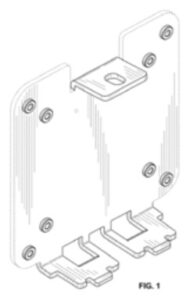By Clarissa Sullivan and John Evans
The Patent Trial and Appeal Board recently designated as informative its decision instituting post-grant review and addressing the issues of design patent functionality in Sattler Tech Corp. v. Humancentric Ventures, LLC. No. PGR2019-00030, 2019 WL 3385172 (P.T.A.B. July 26, 2019). The Sattler decision highlights the importance of balancing the proportions of functional and ornamental features claimed in design patent applications.
Let’s start with some background on the often confusing issue of design patent functionality. Everyone knows that design patents protect the ornamental appearance of useful articles, but only utility patents protect the things that make them useful. That’s why courts read design patents on useful articles as narrow and limited to the particular ornamental designs shown in the drawings; to do otherwise risks expanding design patent scope into the realm of utility patents.
But a design patent that claims the only possible ornamental appearance of a useful article presents a different question: Is anything about this design “ornamental?” If the answer is “no,” then the design patent is not just narrowly construed. It’s invalid under 35 U.S.C. § 171. The classic example of such a purely functional design is a key blank that must be shaped the way it is to fit inside the corresponding lock’s keyway. Best Lock Corp. v. ILCO Unican Corp., 94 F.3d 1563, 1566 (Fed. Cir. 1996) (“An attempt to create a key blade with a different design would necessarily fail because no alternative blank key blade would fit the corresponding lock.”).
Back to Sattler. The patent-at-issue was U.S. Patent No. D823,093 S (“’093 Patent”), entitled “VESA MOUNT ADAPTER BRACKET.” The ’093 patent depicts a standard-based mounting bracket for flat panel monitors, displays, and TVs. As Figure 1 shows, the claimed portions included: (1) top and bottom tabs, and (2) eight raised grommets arranged in diagonal pairs toward the four corners of the plate:
 |
|
Figure 1: “perspective view of a VESA mount adapter bracket” |
Considering each claimed element and the design as a whole, the PTAB held that the design claimed nothing ornamental. 2019 WL 3385172 at *7. The tabs were positioned, shaped, and sized to fit the VESA Standard monitor interface. The grommets were likewise arranged and sized according to the standard. Arguably, the grommets’ raised edges presented an optional feature not required for mounting the monitor. Even so, the functional benefit provided by the raised edges – increasing bracket strength – led the PTAB to conclude they were functional, not ornamental. Id.
While the PTAB’s parsing of each claimed element is probably better suited for claim construction analysis rather than invalidity, the decision properly considers whether the design “as a whole appears primarily functional, rather than primarily ornamental.” Id. And the lack of alternative overall designs weighed heavily in the analysis.
It’s also worth noting that the Sattler decision is merely an institution decision, and the patent owner filed no preliminary response. Accordingly, while the PTAB has designated the Sattler decision as informative, it arose without the benefit of the patent owner’s evidence or argument.
In any event, the key takeaway of Sattler is that special attention should be paid at the claim drafting stage to ensure that the overall claimed design balances functional and ornamental features. For instance, the analysis in Sattler may have come out differently had the applicant claimed more significant ornamental features, such as the shape of the bracket plate’s perimeter or unique grommet shapes.
Latest posts by John Evans, Ph.D. (see all)
- PTAB Issues First Post-LKQ Design Patent Decision - September 27, 2024
- Petitioners Beware: Screenshots Showing Product May Not Qualify as Printed Publication - September 18, 2024
- En Banc Federal Circuit Overrules Rosen-Durling Test for Design Patent Obviousness - May 23, 2024

